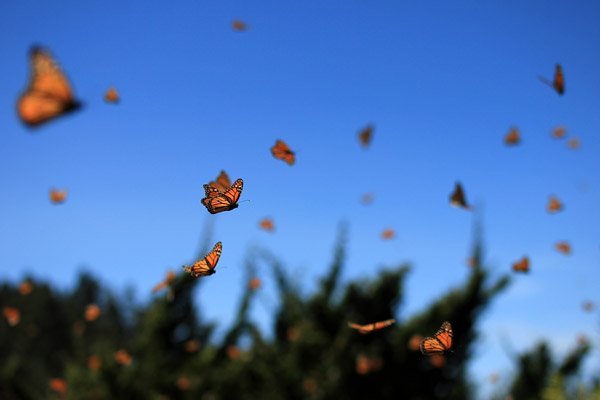Hi! I’m Morgan. Can you guess what type of animal I am? Here are a few clues: I’m black and orange (with a little bit of white), I can fly, and I’m royalty…sort of.
I’m a monarch butterfly! Did you know that monarch is another word for a head of state, like a king or queen? Cool, right?
Monarch butterflies are some pretty impressive creatures, for example, we have the longest migration of all insects in North America! Many of us spend our summers in southern Canada and then fly all the way down to Mexico for the winter. Unfortunately, it’s getting harder for us to make it to our Mexican destination, and climate change has a lot to do with it.


As you might already know, climate change is one of the biggest threats facing animals today. We are seeing extreme weather (like blizzards and droughts) happening more often, ocean levels rising and more and more invasive species taking over habitats, all of which are making it much harder for us to survive.
A big climate change problem for monarch butterflies like me is the changing temperatures. Cold temperatures can stop us from flying…literally! Our flight muscles only work if they’re at a certain temperature so if it gets too cold out, we can’t fly away – we’re stuck there until we warm up.
Not only that, the timing for a lot of the things we do is also based on the temperature outside, including when we hibernate, reproduce and migrate. As the temperature swings from warm to cold, it’s throwing our schedules out of whack.
Even if we do manage to start our migration on time, we aren’t in the clear. The trip to Mexico is a long one and it’s impossible for us to do the whole thing in one go so we rely on stopover sites along the way. These are places where we can eat, rest and recharge. However, our stopover sites are experiencing extreme heat, droughts and wildfires, which threaten our food supply.

For those of us who are able to make it to our migration destination, it’s not the tropical vacation you might expect. Instead, we have to survive severe storms which have been linked to – you guessed it – climate change. Scientists predict that this area of Mexico will get more rainy and wetter as climate change continues, and do you know what happens to a wet butterfly in cold temperatures? We could freeze.
As you can tell, climate change is really tough on monarch butterflies, but it’s not too late for you to help us. Do your part to fight against climate change and help animals like the monarch butterfly!


![]()
Sources:
– c402277.ssl.cf1.rackcdn.com/publications/845/files/original/Monarch_butterfly_-_WWF_wildlife_and_climate_
change_series.pdf
– www.wwf.ca/conservation/species/monarch_butterfly/
– blog.nwf.org/2014/01/monarchs-face-new-threats-losses-along-migration-route/
Hey Ranger – yep, that’s you! Don’t forget to comment on this article, you’ll be one step closer to levelling up! Check your progress on your Journey Map, and remember, you only need 5 comments to reach Level 3 and 15 to reach Level 5. Share your thoughts here – we’d LOVE to hear them!
All comments are moderated before posting, so your comment won’t be visible until we’ve had a chance to check that it’s squeaky clean.

They are really nice when sun shines on there wings in summertime
I did an essay on climate change and I felt so touched and moved about how it affects so many great animals! Usually I see about 5 monarch butterflies in the summer but last year I only saw 1.
I think monarch butterflies are cool
That is great
Last year my class studied monarch butterflies and kept them as pets. Then let them free.
mine too
these butterflies are sooooo beautiful
i love monarchs they are beautiful
I love monarch butterflies there beautiful we see a lot here in b.c
how do fish grow
I love Savin anmos
I love feedin the brsd
I haven’t seen a monarch butterfly in a long time and I hope that there will be more in the future
I HAD A BUTTER FLY LAND ON MY SHOULDER ONCE. I FELT THE POWER
i read a book on monarch butterflys and thy are intresting
morgan is a monarch butterfly
they are pretty cool (and also pretty).